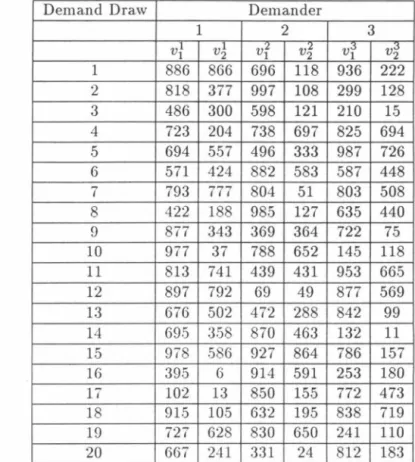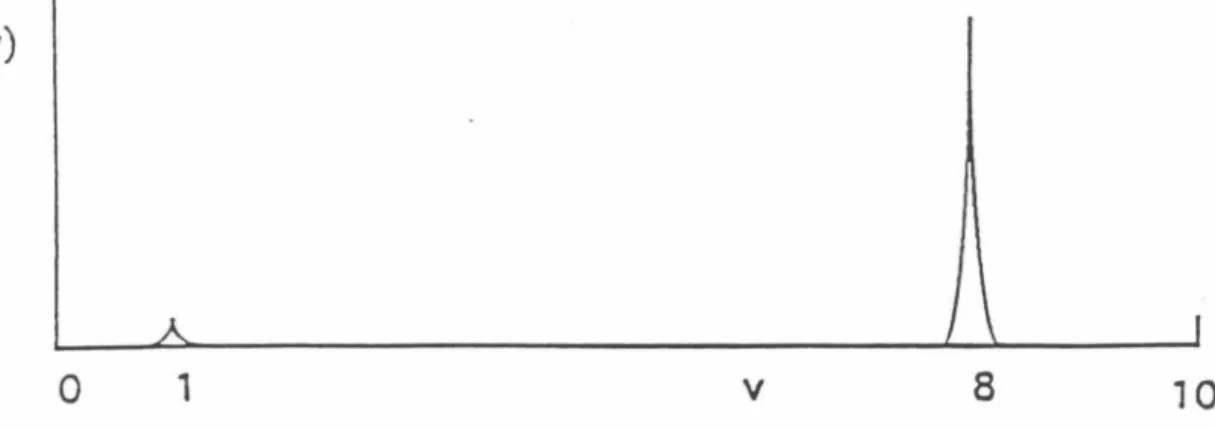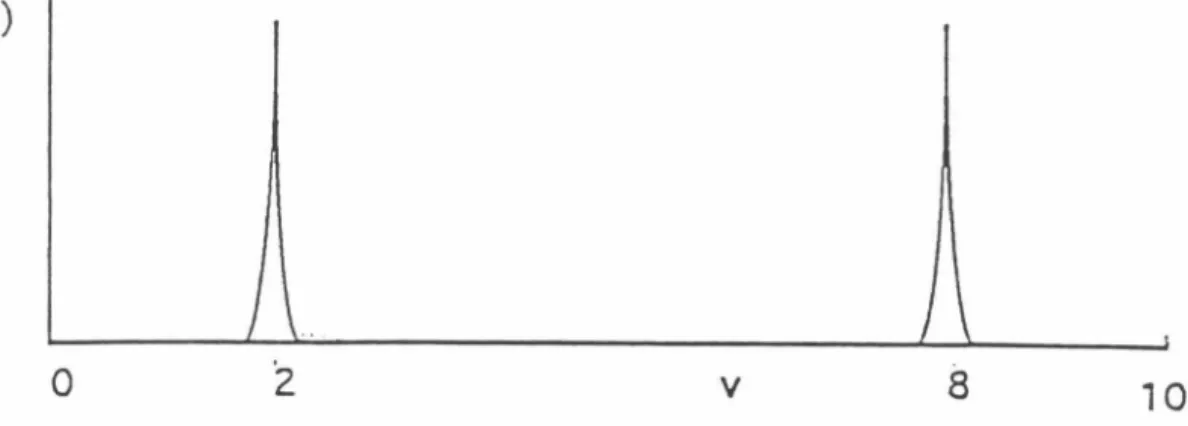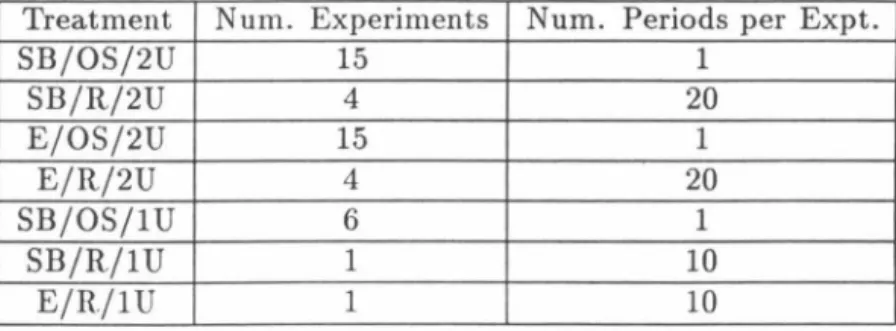We derive the necessary and sufficient conditions for a set of bidding strategies to be a symmetric monotone equilibrium to a uniform price sealed bid auction. We also prove that the uniform price sealed bid auction and the English clock are not isomorphic in the two-unit demand environment. In the experimental setting, more revenue is generated by the uniform price sealed bid auction than the English clock, and more revenue is generated per market period if the market is run only once than if it is repeated with the same participants.
65 3.6 Strategies of the Claimants in the Uniform Price Auction of Two Units 72 3.7 Strategies of the Claimants in the Uniform Price Auction (One-Shot Games, number of 0 observations).
INTRODUCTION 1
Chapter 1
Introduction
- INTRODUCTION 2
- INTRODUCTION 3
- Previous Theoretical Literature
- INTRODUCTION 4
- INTRODUCTION 5
- INTRODUCTION 6
- INTRODUCTION 7
- CHAPTER 1. INTRODUCTION 8
- INTRODUCTION 9
- INTRODUCTION 11
- INTRODUCTION 12
- Previous Experimental Work
- INTRODUCTION 13 Nash equilibrium performs poorly in explaining the data from corresponding experiments
- INTRODUCTION 14
- INTRODUCTION
- This Dissertation
- THE UNIFORM PRICE SEALED BID AUCTION 16
- Chapter 2
The rules of the uniform price sealed bid auction specify that all applicants submit sealed bids for the object(s) at the same time. Wilson (1979) considers the case when the item to be sold is divisible and demanders have continuously downward-sloping demand functions for fractions (shares) of the good. Risk aversion of the bidders results in the first price sealed bid auction yielding higher average revenue (Weber (1983)).
In general, in the case of single-unit claims, the predictions of the dominant strategy equilibria of the uniform price sealed bids and English auctions are supported.
The Uniform Price Sealed Bid Auction
THE UNIFORM PRICE SEALED BID AUCTION
- The Model
- The Game
The highest k bids are accepted and the corresponding requestors pay a per-unit price equal to the k + 1st highest bid. A tie for kth highest bid is broken by randomly awarding a unit to one of the tiebreakers. Suppose for simplicity (and only for the example) that there is complete information, so that each buyer knows all the valuations of the others.
THE UNIFORM PRICE SEALED BID AUCTION 18
- Symmetric Equilibria
THE UNIFORM PRICE SEALED BID AUCTION 19
Definition 4
THE UNIFORM PRICE SEALED BID AUCTION 20
Definition 5
THE UNIFORM PRICE SEALED BID AUCTION 21
THE UNIFORM PRICE SEALED BID AUCTION 22 Proof: Suppose all n+1 bidders are using the same equilibrium bidding function
THE UNIFORM PRICE SEALED BID AUCTION 23
THE UNIFORM PRICE SEALED BID AUCTION 24 The first order necessary (Kuhn- Tucker) conditions are given by
THE UNIFORM PRICE SEALED BID AUCTION 25
THE UNIFORM PRICE SEALED BID AUCTION 26
THE UNIFORM PRICE SEALED BID AUCTION 28
THE UNIFORM PRICE SEALED BID AUCTION 31
THE UNIFORM PRICE SEALED BID AUCTION 32
THE UNIFORM PRICE SEALED BID AUCTION 33
THE UNIFORM PRICE SEALED BID AUCTION 34
THE UNIFORM PRICE SEALED BID AUCTION 35
THE UNIFORM PRICE SEALED BID AUCTION
THE UNIFORM PRICE SEALED BID AUCTION 37
THE UNIFORM PRICE SEALED BID AUCTION 38
THE UNIFORM PRICE SEALED BID AUCTION 39
THE UNIFORM PRICE SEALED BID AUCTION 40
THE UNIFORM PRICE SEALED BID AUCTION 41
THE UNIFORM PRJCE SEALED BID AUCTION 42
- Large Numbers of Bidders
THE UNIFORM PRICE SEALED BID AUCTION 43
THE UNIFORM PRICE SEALED BID AUCTION 44
THE UNIFORM PRICE SEALED BID AUCTION 45
THE UNIFORM PRICE SEALED BID AUCTION
THE UNIFORM PRICE SEALED BID AUCTION 47
UNIFORM PRICE AUCTION VS. ENGLISH CLOCK 48
Chapter 3
Uniform Price Auction vs
English Clock
UNIFORM PRICE AUCTION VS. ENGLISH CLOCK 49
- Theoretical Non-Equivalence
We also statistically test the predictions of the dominant strategic equilibria of both types of auctions in the one-unit demand environment, the symmetric monotone Hayes-Nash equilibrium of the uniform price auction in the two-unit demand environment, as well as the revenue equivalence of the two auctions. The purpose of this section is to show that the uniform price sealed bid auction and the English dock do not necessarily generate identical expected revenues and allocative efficiencies in their respective symmetric equilibria. Either the English hour or the uniform price sealed bid auction may generate higher expected revenue or a local efficiency.
UNIFORM PRICE AUCTION VS. ENGLISH CLOCK 50
The allocation is efficient because the units are obtained by the demander(s) for whom they have the greatest value. At price 1, bidder 3 reduces his demand from one unit to zero units because he does not want to win the unit at a price higher than its value to him. The final distribution is as follows: buyers one and two each receive one unit and the market price is 1 + f.
Case one obtains the same outcome as in example 4 we just discussed, but with claimants 2 and 3 reversed.
UNIFORM PRICE AUCTION VS. ENGLISH CLOCK 52
UNIFORM PRICE AUCTION VS. ENGLISH CLOCK
UNIFORM PRICE AUCTION VS. ENGLISH CLOCK 54
- Experimental Design: Motivation
We have seen that the theoretical strategic isomorphism and revenue equivalence results, which hold when demands are unitary in the environment of independent private values, do not necessarily hold when demands are multi-unit. The difference between the two mechanisms is that the English clock allows demanders to adjust their beliefs about the valuations of other demanders as the price rises. The revenue equivalence theorem only considers auctions in which the final allocations are efficient in equilibrium.
For multi-unit demands, the revenue equivalence theorem does not apply since inefficient allocations can occur in equilibrium. However, we have shown that this does not necessarily extend to generalizations of multi-unit demand from single-unit auctions, to which it does apply. This section describes the design of our laboratory experiment, in which we investigate the yield and efficiency properties of the two auctions under different conditions.
English Time: \'We have seen in the previous subsection that when searchers are playing equilibrium strategies, the two auctions can generate different prices. Since a one-shot game and a repeated game in which the players do not know when the game ends have fundamentally different equilibrium properties, the outcome is likely to be different under the two conditions. Two-unit requests: V-/e have seen that when requests are multi-unit, requesters, even when behaving uncooperatively, may have an incentive to under-disclose their requests.
In the experiments, we compare outcomes of environments in which market demand is identical, but in which individual demands are varied. In a way, the two-unit plaintiffs can be viewed as two one-unit plaintiffs who collude to maximize the sum of their individual profits and thus the experiments can provide insight into its impact.
UNIFORM PRICE AUCTION VS. ENGLISH CLOCK 57
- Experimental Design: Environment and Parameters
- Procedures
UNIFORM PRICE AUCTION VS. ENGLISH CLOCK 58
The program then showed them the price per unit and how many of their bids were accepted. One shot: Each experimental session, subjects manually filled out their bids on a form that was distributed to them. They were told that they would be grouped into a market with bidders from different experimental sessions.
This procedure was to ensure that they could not learn anything about their opponents from practice periods or by any other means.2 The form can be found in appendix B.3. While the experimenter transcribed the information on the blackboard, each subject indicated the number of units he wanted at the current price. Students in the course could participate in experiments and the money they earned would be given to them after the course was completed.
This process had been in place for several years, so subjects knew they would actually be paid. 3Dealing of the demand for one unit was done only as a repeated game and not as a one-shot game. One-shot games would involve many additional trials, and given the very strong tendency of demanders to truly bid in repeated games (even in the first period), and previous experimental research, our predecessors were very strong, which we observed dominant strategy equilibrium results in one shot games.
4 "Francs" is a general name for the experimental currency according to which units of goods are valued.
UNIFORM PRICE AUCTION VS. ENGLISH CLOCK 60
- Predictions
UNIFORM PRICE AUCTION VS. ENGLISH CLOCK 61
UNIFORM PRICE AUCTION VS. ENGLISH CLOCK 62
UNIFORM PRICE AUCTION VS. ENGLISH CLOCK 63
- Results
UNIFORM PRICE AUCTION VS. ENGLISH CLOCK 64
UNIFORM PRICE AUCTION VS. ENGLISH CLOCK 65
UNIFORM PRICE AUCTION VS. ENGLISH CLOCK 66
UNIFORM PRICE AUCTION VS. ENGLISH CLOCK 67
UNIFOR.M PRICE AUCTION VS. ENGLISH CLOCK 68
UNIFORM PRICE AUCTION VS. ENGLISH CLOCK 69
UNIFORM PRICE AUCTION VS. ENGLISH CLOCK 70
UNIFORM PRICE AUCTION VS. ENGLISH CLOCK 71
UNIFORM PRICE AUCTION VS. ENGLISH CLOCK 72
UNIFORM PRICE AUCTION VS. ENGLISH CLOCK 73
UNIFORM PRICE AUCTION VS. ENGLISH CLOCK 74
UNIFORM PRICE AUCTION VS. ENGLISH CLOCK 75
SUMMARY AND CONCLUDING REMARKS 76
Chapter 4
Summary and Concluding Remarks
SUMMARY AND CONCLUDING REMARKS 77
Perhaps not surprisingly, bidders show an increasing tendency to behave like price takers as the market thickens and each bidder's ability to influence the market price declines. In chapter three we compared generalizations of two common auction forms and incorporated the idea of multi-unit claims. We have seen that the theoretical strategic and income equivalence results, which hold when demands are single-unit in the independent private value environment, do not necessarily hold when they are multi-unit.
In the experiments where there was a uniform distribution of valuations, we observed that the uniform price auction generated more revenue than the English clock in the two-unit demand condition, suggesting that a revenue-maximizing seller might use the uniform price. auction rather than the English clock in environments similar to the two-unit experimental environment. We also found that less revenue was generated when the auctions were played repeatedly than when they were played only once. We conclude, citing both theoretical and experimental evidence, that in multi-unit demand environments the two mechanisms are fundamentally different from each other.
This result stands in stark contrast to much of the previous theoretical and experimental literature on single-unit demand-independent private value environments.
Appendix A
Additional Lemmas
The last term results from the fact that the underbid for the highest valued unit is dominated by the bid of an amount equal to the highest estimate and from the fact that vf ~ v~. It follows that H(x, y, G, n, m., e), the product of twice differentiable functions, is twice differentiable with respect to x and y (see Marsden p. 171) and thus continuous in x and y. Fv(x) is twice differentiable at x since the sum of differentiable functions is differentiable, (Marsden p. 199).
E7ri is differentiable in bi and b~ because an anti-derivative of a continuous function is differentiable (Marsden p. 286).
Appendix B
- Specific Instructions for the English Clock
- Specific Instructions for the Uniform Price Sealed Bid Auction
- Forms
The experiment will be divided into a series of trading periods where you have to make decisions. You can obtain units of the item by participating in the market process described below. For the first unit that you purchase during the trading period marked at the top of the page, you will receive the amount indicated in row (1) marked 1st Unit Redemption Value.
At the end of the period, record the total profit on the last line of the page. Each of the groups will be in a separate market, meaning they will be bidding on a different set of units. The experimenter will notify you if there is a change in group members.
Since the total amount requested is greater than the number of units available, the price will be increased and new requests must be submitted. If a price increase results in total inquiries of less than the number of available units, then the price will be reduced until a price where the total number of inquiries equals this number. Each of the groups will be in a separate market, that is, they offer one.
Once all participants have submitted their bids, all bids will be ranked from highest to lowest. The unit price for all the accepted bids is equal to the highest rejected bid, i.e.

Unit · REDEMPTION VALUES 1
Unit BID 1
Appendix C
- Valuations
Only one solution is strictly monotone in the interval (0,1) and is shown in Figure C.l. We have verified that the last equation is satisfied by the solution shown in the graph. Tables C.l and C.2 show the value to subjects, in terms of "francs", the experimental currency, of receiving commodity trading in our experimental market.
In each of the eight repeated two-unit demand game experiments, all twenty demand draws were used.

BIBLIOGRAPHY 95
Bibliography
BIBLIOGRAPHY 96
BIBLIOGRAPHY 97









